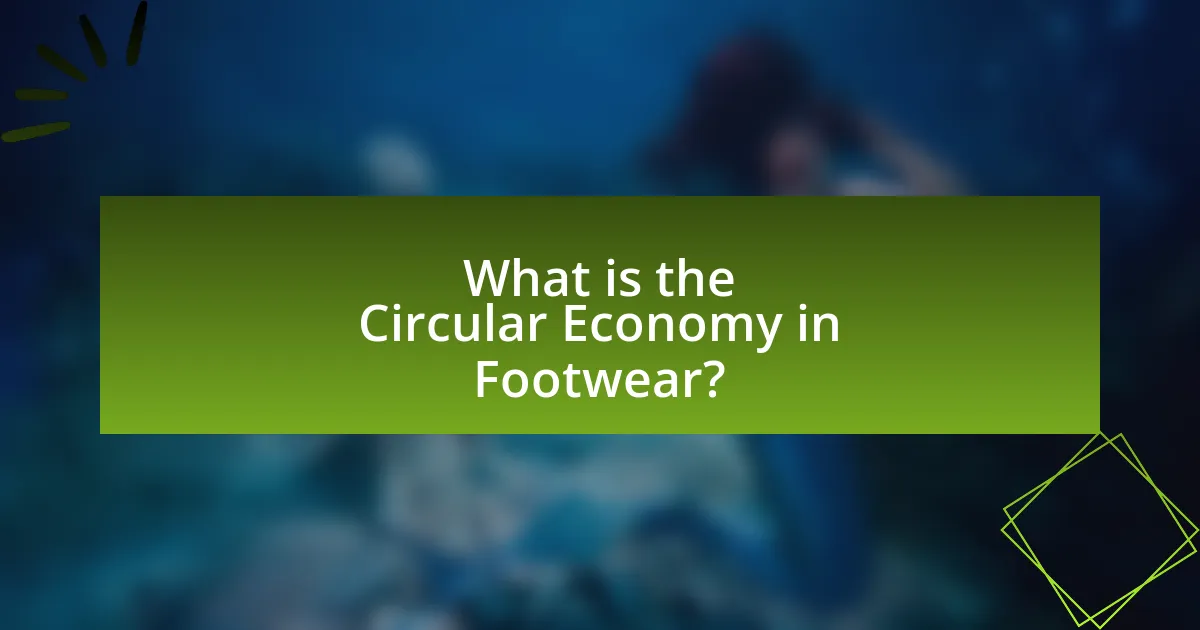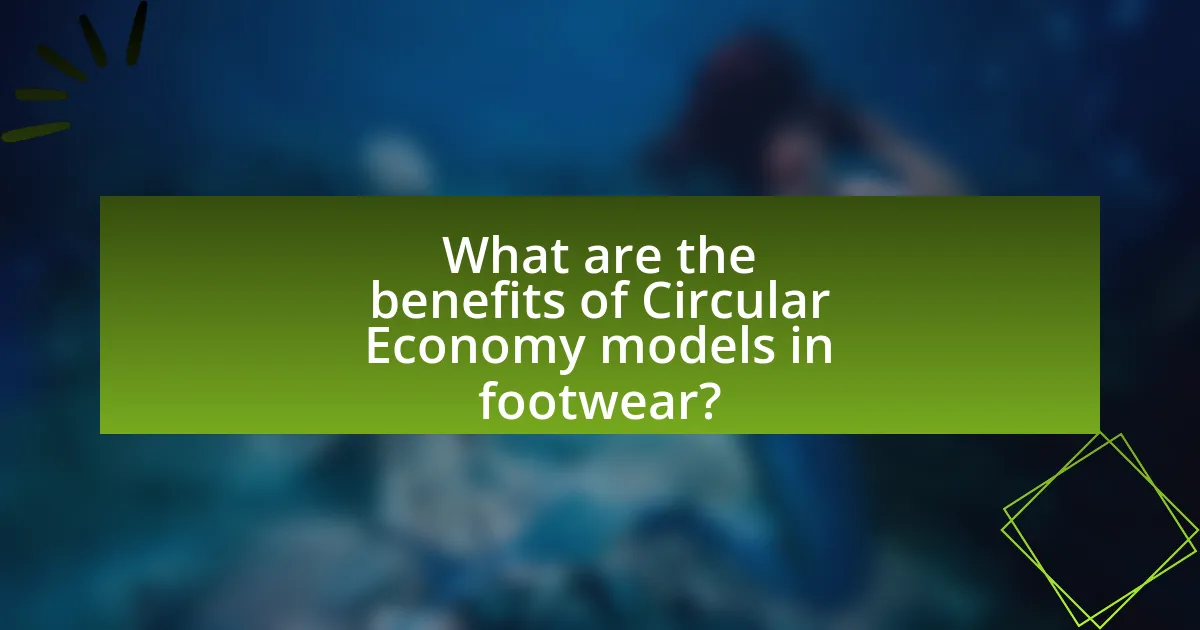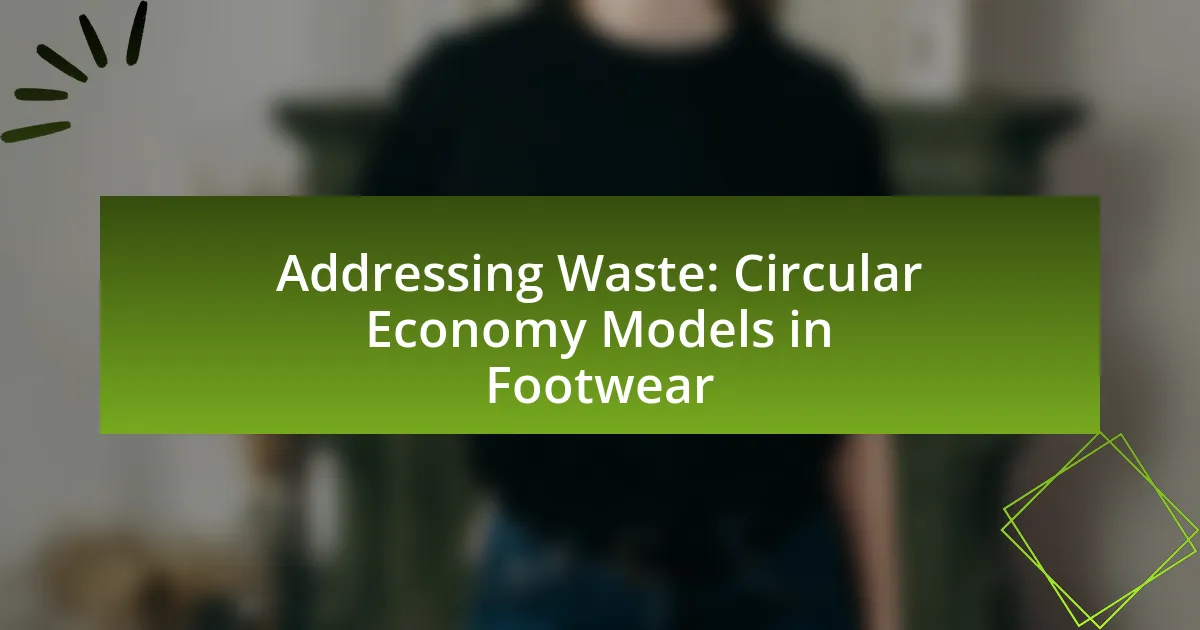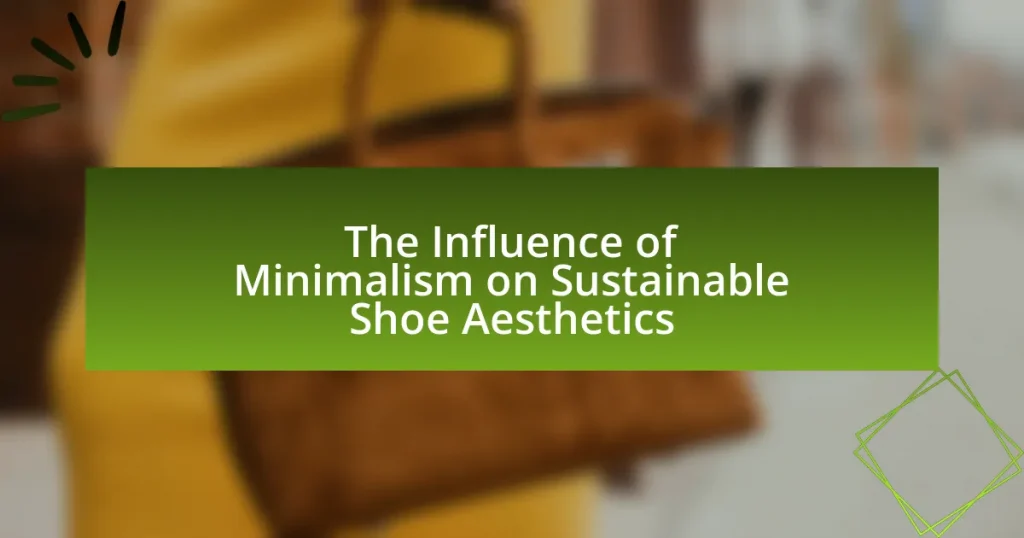The article focuses on the Circular Economy in the footwear industry, a sustainable model that promotes the continuous use of resources through design for longevity, repairability, and recyclability. It contrasts this approach with traditional linear models that contribute to waste and resource depletion. Key principles discussed include sustainable materials, recycling, upcycling, and take-back programs, which collectively aim to minimize environmental impact and enhance resource efficiency. The article also highlights the significant role of consumer behavior, the environmental impacts of traditional footwear production, and the economic advantages of adopting Circular Economy practices, emphasizing the need for brands to implement sustainable strategies to address waste effectively.

What is the Circular Economy in Footwear?
The Circular Economy in Footwear is a sustainable model that emphasizes the continuous use of resources by designing products for longevity, repairability, and recyclability. This approach aims to minimize waste and reduce the environmental impact of footwear production by keeping materials in circulation through processes such as recycling, refurbishing, and remanufacturing. For instance, brands like Nike and Adidas have implemented take-back programs that allow consumers to return old shoes for recycling, thereby reducing landfill waste and promoting resource efficiency.
How does the Circular Economy differ from traditional linear models?
The Circular Economy differs from traditional linear models by emphasizing resource regeneration and sustainability rather than a take-make-dispose approach. In traditional linear models, products are created, used, and then discarded, leading to significant waste and resource depletion. In contrast, the Circular Economy promotes the continuous use of resources through recycling, reusing, and refurbishing, thereby minimizing waste and environmental impact. For instance, according to the Ellen MacArthur Foundation, transitioning to a Circular Economy could generate $4.5 trillion in economic benefits by 2030, highlighting its potential for sustainable growth compared to the limitations of linear models.
What are the key principles of the Circular Economy in footwear?
The key principles of the Circular Economy in footwear include designing for longevity, using sustainable materials, promoting recycling and upcycling, and implementing take-back programs. Designing for longevity ensures that footwear is durable and can withstand wear, reducing the need for frequent replacements. Sustainable materials, such as recycled plastics and organic textiles, minimize environmental impact during production. Recycling and upcycling initiatives allow old footwear to be transformed into new products, thereby reducing waste. Take-back programs encourage consumers to return used footwear for proper recycling or repurposing, closing the loop in the product lifecycle. These principles collectively aim to reduce waste and promote sustainability in the footwear industry.
How does waste reduction play a role in the Circular Economy?
Waste reduction is fundamental to the Circular Economy as it minimizes resource extraction and environmental impact. In a Circular Economy, the focus is on designing products for longevity, reuse, and recycling, which inherently reduces waste generated during production and consumption. For instance, the Ellen MacArthur Foundation reports that transitioning to a Circular Economy could reduce global greenhouse gas emissions by 39% by 2030, highlighting the significant environmental benefits of waste reduction. By prioritizing waste reduction, businesses can enhance sustainability, lower costs, and create a more resilient economic model.
Why is addressing waste important in the footwear industry?
Addressing waste is crucial in the footwear industry because it significantly impacts environmental sustainability and resource efficiency. The footwear sector generates approximately 23 billion pairs of shoes annually, contributing to substantial landfill waste and carbon emissions. By implementing waste reduction strategies, such as recycling materials and adopting circular economy models, the industry can minimize its ecological footprint and promote sustainable practices. For instance, a study by the Ellen MacArthur Foundation highlights that transitioning to a circular economy could reduce global footwear waste by 80% by 2030, demonstrating the potential for significant environmental benefits.
What environmental impacts are associated with traditional footwear production?
Traditional footwear production is associated with significant environmental impacts, including high levels of waste, pollution, and resource depletion. The manufacturing process often involves the use of toxic chemicals, such as adhesives and dyes, which can contaminate water sources and harm ecosystems. Additionally, the production of leather contributes to deforestation and greenhouse gas emissions, as livestock farming is a major driver of land use change. According to the United Nations Environment Programme, the footwear industry generates approximately 23 billion pairs of shoes annually, leading to substantial waste in landfills, where synthetic materials can take hundreds of years to decompose. These factors highlight the urgent need for sustainable practices within the footwear sector to mitigate environmental harm.
How does consumer behavior influence waste in footwear?
Consumer behavior significantly influences waste in footwear through purchasing patterns, product usage, and disposal practices. For instance, the trend of fast fashion encourages consumers to buy cheaper, lower-quality shoes more frequently, leading to increased waste as these items are discarded after short use. According to a report by the Ellen MacArthur Foundation, the global footwear industry generates over 23 billion pairs of shoes annually, with a substantial portion ending up in landfills due to consumer preferences for novelty over durability. Additionally, consumers often lack awareness of sustainable disposal methods, further exacerbating waste issues. This behavior highlights the need for education on sustainable practices and the promotion of circular economy models to mitigate waste in the footwear sector.

What are the different Circular Economy models applied in footwear?
The different Circular Economy models applied in footwear include product-as-a-service, recycling and upcycling, and take-back schemes. Product-as-a-service allows consumers to rent footwear instead of purchasing, promoting reuse and reducing waste. Recycling and upcycling involve transforming old shoes into new products, thereby minimizing landfill contributions. Take-back schemes encourage consumers to return used footwear to manufacturers for responsible disposal or refurbishment, further supporting sustainability efforts. These models collectively aim to reduce environmental impact and promote resource efficiency in the footwear industry.
How do recycling and upcycling contribute to Circular Economy models?
Recycling and upcycling are essential components of Circular Economy models as they facilitate the continuous use of materials, thereby reducing waste and resource consumption. Recycling transforms waste materials into new products, minimizing the need for virgin resources; for instance, recycling one ton of plastic can save up to 7.4 cubic yards of landfill space and reduce greenhouse gas emissions. Upcycling, on the other hand, creatively repurposes waste into products of higher value, which not only extends the lifecycle of materials but also encourages innovation in product design. Together, these practices support the Circular Economy by promoting sustainability, reducing environmental impact, and fostering economic growth through the creation of new markets and job opportunities in the recycling and upcycling sectors.
What are the processes involved in recycling footwear materials?
The processes involved in recycling footwear materials include collection, sorting, shredding, and reprocessing. Initially, footwear is collected from various sources, including consumers and retailers. After collection, the materials are sorted based on type, such as rubber, leather, and textiles. Following sorting, the materials are shredded into smaller pieces to facilitate further processing. Finally, the shredded materials undergo reprocessing, where they can be transformed into new products or raw materials, contributing to a circular economy by reducing waste and conserving resources. This systematic approach ensures that valuable materials are reused, minimizing environmental impact.
How does upcycling create new value from waste materials?
Upcycling creates new value from waste materials by transforming discarded items into products of higher quality or value. This process not only reduces waste but also conserves resources by minimizing the need for new raw materials. For instance, in the footwear industry, brands often repurpose old shoes or manufacturing scraps into new footwear designs, effectively extending the lifecycle of materials. According to a study by the Ellen MacArthur Foundation, upcycling can significantly reduce environmental impact, as it diverts waste from landfills and lowers carbon emissions associated with production.
What role do brands play in implementing Circular Economy models?
Brands play a crucial role in implementing Circular Economy models by designing products for longevity, recyclability, and resource efficiency. They influence consumer behavior through sustainable practices, such as using recycled materials and promoting take-back programs, which encourage the return of used products for recycling or repurposing. For instance, companies like Nike and Adidas have introduced initiatives that focus on reducing waste by creating shoes from recycled plastics and offering programs to recycle old footwear. These actions not only minimize environmental impact but also set industry standards, driving competitors to adopt similar sustainable practices.
How are leading footwear brands adopting sustainable practices?
Leading footwear brands are adopting sustainable practices by implementing circular economy models that focus on reducing waste and promoting recycling. For instance, companies like Nike and Adidas have introduced programs that encourage consumers to return used shoes for recycling, transforming them into new products. Nike’s “Reuse-A-Shoe” initiative has recycled over 30 million pairs of shoes since its inception, while Adidas has committed to using recycled ocean plastic in its products, aiming for 100% sustainable cotton by 2024. These practices not only minimize environmental impact but also align with consumer demand for eco-friendly products, demonstrating a significant shift towards sustainability in the footwear industry.
What challenges do brands face in transitioning to Circular Economy models?
Brands face significant challenges in transitioning to Circular Economy models, primarily due to the complexity of redesigning supply chains and product life cycles. This complexity includes the need for new materials that are sustainable and recyclable, which often require substantial investment in research and development. Additionally, brands encounter difficulties in changing consumer behavior and perceptions, as many consumers are not yet fully aware of or committed to sustainable practices. According to a report by the Ellen MacArthur Foundation, only 9% of the global economy is currently circular, highlighting the widespread challenges brands face in adopting these models. Furthermore, regulatory hurdles and the lack of standardized metrics for measuring circularity complicate the transition process, making it difficult for brands to assess their progress and impact effectively.

What are the benefits of Circular Economy models in footwear?
Circular Economy models in footwear significantly reduce waste and resource consumption. By promoting the reuse, recycling, and refurbishment of materials, these models extend the lifecycle of products and minimize landfill contributions. For instance, a study by the Ellen MacArthur Foundation highlights that transitioning to a circular economy could reduce global footwear waste by up to 80% by 2030. Additionally, these models foster innovation in sustainable materials, leading to lower carbon footprints and enhanced brand loyalty among environmentally conscious consumers.
How do these models impact environmental sustainability?
Circular economy models in footwear significantly enhance environmental sustainability by minimizing waste and promoting resource efficiency. These models encourage the design of products that can be reused, repaired, or recycled, thereby reducing the volume of waste sent to landfills. For instance, companies implementing circular practices have reported up to a 50% reduction in material consumption and a 70% decrease in carbon emissions compared to traditional linear models. This shift not only conserves natural resources but also fosters a sustainable lifecycle for products, aligning with global sustainability goals.
What reductions in carbon footprint can be achieved through Circular Economy practices?
Circular Economy practices can achieve carbon footprint reductions of up to 70% in the footwear industry. By emphasizing recycling, reusing materials, and designing for longevity, these practices minimize waste and resource extraction. For instance, a study by the Ellen MacArthur Foundation highlights that transitioning to a circular model in the fashion sector could reduce greenhouse gas emissions by 44% by 2030. This significant reduction is attributed to decreased reliance on virgin materials and enhanced product lifecycle management, which collectively lower the overall environmental impact of footwear production and consumption.
How does resource efficiency improve with Circular Economy models?
Resource efficiency improves with Circular Economy models by maximizing the use of materials and minimizing waste throughout the product lifecycle. In Circular Economy frameworks, products are designed for longevity, repairability, and recyclability, which reduces the need for virgin resources. For instance, a study by the Ellen MacArthur Foundation indicates that transitioning to a Circular Economy could lead to a reduction of up to 70% in resource consumption in certain industries, including footwear. This model promotes the reuse of materials, thereby decreasing the environmental impact and enhancing overall resource efficiency.
What economic advantages do Circular Economy models offer to businesses?
Circular Economy models offer businesses significant economic advantages, including cost savings, increased resource efficiency, and enhanced brand loyalty. By minimizing waste and maximizing the use of materials, companies can reduce operational costs; for instance, a study by the Ellen MacArthur Foundation found that transitioning to a circular model could save businesses up to $630 billion annually in the European Union alone. Additionally, these models promote innovation in product design and materials, leading to new revenue streams and market opportunities. Companies adopting circular practices often experience improved customer engagement and loyalty, as consumers increasingly prefer sustainable brands.
How can cost savings be realized through waste reduction?
Cost savings can be realized through waste reduction by minimizing material costs and improving operational efficiency. When companies in the footwear industry implement waste reduction strategies, such as reusing materials and optimizing production processes, they can significantly lower expenses associated with raw materials and waste disposal. For instance, a study by the Ellen MacArthur Foundation found that adopting circular economy principles could lead to a 20% reduction in material costs for businesses. This demonstrates that effective waste management not only conserves resources but also enhances profitability by reducing unnecessary expenditures.
What new market opportunities arise from sustainable footwear practices?
Sustainable footwear practices create new market opportunities by appealing to environmentally conscious consumers and promoting circular economy models. The rise in demand for eco-friendly products has led to a significant market segment focused on sustainable materials, such as recycled plastics and organic textiles, which can enhance brand loyalty and attract new customers. According to a report by Grand View Research, the global sustainable footwear market is expected to reach $8.5 billion by 2025, indicating a growing consumer preference for sustainable options. Additionally, brands adopting circular economy principles, such as take-back programs and recycling initiatives, can differentiate themselves in a competitive market, further driving sales and customer engagement.
What are practical steps for implementing Circular Economy practices in footwear?
To implement Circular Economy practices in footwear, companies should focus on designing for longevity, utilizing sustainable materials, and establishing take-back programs. Designing for longevity involves creating durable products that can withstand wear and tear, which reduces the frequency of replacements. Utilizing sustainable materials, such as recycled plastics or organic cotton, minimizes environmental impact and resource depletion. Establishing take-back programs encourages consumers to return used footwear for recycling or refurbishment, thus closing the loop in the product lifecycle. These steps align with the principles of the Circular Economy, which aims to reduce waste and promote resource efficiency in the footwear industry.
How can consumers contribute to a Circular Economy in footwear?
Consumers can contribute to a Circular Economy in footwear by choosing sustainable brands, participating in recycling programs, and extending the life of their shoes. By selecting brands that prioritize eco-friendly materials and ethical production practices, consumers support businesses that align with circular economy principles. Engaging in recycling initiatives, such as returning old footwear to manufacturers for refurbishment or recycling, helps reduce waste and promotes resource recovery. Additionally, consumers can extend the lifespan of their footwear through proper care and repair, minimizing the need for new purchases and reducing overall consumption. These actions collectively foster a more sustainable footwear industry and decrease environmental impact.
What best practices should brands follow to enhance sustainability?
Brands should adopt circular economy principles to enhance sustainability. This involves designing products for longevity, using recyclable or biodegradable materials, and implementing take-back programs to reclaim used products. For instance, companies like Nike and Adidas have initiated programs to recycle old shoes into new products, significantly reducing waste. Additionally, brands should prioritize transparency in their supply chains, ensuring ethical sourcing and production practices. Research indicates that sustainable practices can lead to a 20-30% reduction in carbon emissions, highlighting the effectiveness of these strategies in promoting environmental responsibility.



